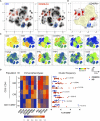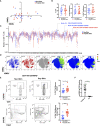A Virus-Specific Immune Rheostat in the Immunome of Patients Recovering From Mild COVID-19
- PMID: 34113347
- PMCID: PMC8185226
- DOI: 10.3389/fimmu.2021.674279
A Virus-Specific Immune Rheostat in the Immunome of Patients Recovering From Mild COVID-19
Abstract
An accurate depiction of the convalescent COVID-19 immunome will help delineate the immunological milieu crucial for disease resolution and protection. Using mass cytometry, we characterized the immune architecture in patients recovering from mild COVID-19. We identified a virus-specific immune rheostat composed of an effector T (Teff) cell recall response that is balanced by the enrichment of a highly specialized regulatory T (Treg) cell subset. Both components were reactive against a peptide pool covering the receptor binding domain (RBD) of the SARS-CoV-2 spike glycoprotein. We also observed expansion of IFNγ+ memory CD4+ T cells and virus-specific follicular helper T (TFH) cells. Overall, these findings pinpoint critical immune effector and regulatory mechanisms essential for a potent, yet harmless resolution of COVID-19 infection.
Keywords: COVID-19; SARS-CoV-2; follicular helper T cells; mass cytometry; regulatory T cells.
Copyright © 2021 Yeo, Leong, Tay, Nadua, Anderson, Lim, Ng, Poh, Guo, Yaung, Kumar, Wasser, Hazirah, Sutamam, Chua, Qui, Foo, Gamage, Yeo, Ramakrishna, Arkachaisri, Young, Lye, Wang, Chong, Tan, Li, Kam, Ginhoux, Thoon, Chan, Yung and Albani.
Conflict of interest statement
The authors declare that the research was conducted in the absence of any commercial or financial relationships that could be construed as a potential conflict of interest.
Figures




References
Publication types
MeSH terms
Substances
LinkOut - more resources
Full Text Sources
Medical
Research Materials
Miscellaneous

